Animal model for parkinson's disease
a parkinson's disease and animal model technology, applied in the field of animal model for parkinson's disease, can solve the problems of lack of appropriate, physiologically relevant animal model, difficult drug testing, and inability to understand the mechanisms underlying this neuronal loss in parkinson's diseas
- Summary
- Abstract
- Description
- Claims
- Application Information
AI Technical Summary
Benefits of technology
Problems solved by technology
Method used
Image
Examples
example 1
DOPAL is a Major DA Metabolite in Human Brain
[0085]Levels of 3,4-dihydroxyphenylacetaldehyde (DOPAL), dopamine (DA), homovanillic acid (HVA) were determined in substantia nigra (SN), caudate and putamen from a 67-year-old man with a post-mortem interval of 8.3 h using MHPLC-EC (Table 1). Values are means±SE of at least six replicates of each chemical. Results indicate that DOPAL is a major dopamine metabolite in human SN and its projections.
TABLE 1Levels of DOPAL, DA and-HVA in humansubstantia nigra and striatum.Brain tissue (pg / mg wet weight)CompoundCaudatePutamenSubstantia NigraDOPAL149 ± 3.7120 ± 2.9397 ± 4.8HVA113 ± 2.7132 ± 3.5321 ± 4.9DA191 ± 4.4 99 ± 2.5275 ± 4.9
example 2
DOPAL is Toxic in Vitro PC-12 Cells
[0086]DOPAL, as well as other physiologically metabolites and adducts, were added to PC12 cells in culture at concentrations that were physiologically relevant. The results indicated that DOPAL, but not Dopamine, Homovanillic acid, DOPAC or Tetrahydropapaveroline were toxic in vitro at physiological levels (Table 2).
TABLE 2DOPAL, Dopamine, Homovanillic acid,DOPAC and Tetrahydropapaveroline wereadded to PC12 cells in culture.Compound addedPC 12 cells / well × 103Experiment 1None299 ± 19DOPAL (66 μM)100 ± 5aDopamine (66 μM)329 ± 21Homovanillic acid (66 μM)322 ± 20DOPAC (66 μM)334 ± 10Tetrahydropapaveroline (66 μM)346 ± 15Experiment 2None143 ± 12DOPAL (30 μM)107 ± 10bDOPAL (30 μM + rotenone 10 μM) 61 ± 9cRotenone (10 μM)127 ± 9Experiment 3None141 ± 22DOPAL (6.6 μM)105 ± 12b
example 3
DOPAL Triggers Aggregation of Purified α-Synuclein in Test Tube Experiments
[0087]Western blot analysis was performed to analyze DOPAL-induced aggregation of α-synuclein (FIG. 1). DOPAL was dissolved in 1% benzyl alcohol, then diluted to a final concentration of 1.5-, 500 μM. AS (2 μM) was incubated at 37° C. in 20 μl of 100 mM tris-HCl buffer (pH 7.2) with or without DA, DOPAL (1.5-1,500 μM), DOPAC, or homovanillic acid (HVA) for up to 4 h. The reaction was stopped by heating at 70° C. for 3 min in SDS buffer. Results indicated that DOPAL, but not DA or its other metabolites, triggers dose-dependent aggregation of α-synuclein oligomers of increasing size in vitro. (see Burke et al. Acta Neuropath, 115:193-203, 2008)
PUM
| Property | Measurement | Unit |
|---|---|---|
| wet weight | aaaaa | aaaaa |
| wet weight | aaaaa | aaaaa |
| concentration | aaaaa | aaaaa |
Abstract
Description
Claims
Application Information
 Login to View More
Login to View More - R&D
- Intellectual Property
- Life Sciences
- Materials
- Tech Scout
- Unparalleled Data Quality
- Higher Quality Content
- 60% Fewer Hallucinations
Browse by: Latest US Patents, China's latest patents, Technical Efficacy Thesaurus, Application Domain, Technology Topic, Popular Technical Reports.
© 2025 PatSnap. All rights reserved.Legal|Privacy policy|Modern Slavery Act Transparency Statement|Sitemap|About US| Contact US: help@patsnap.com



